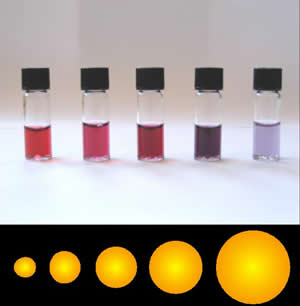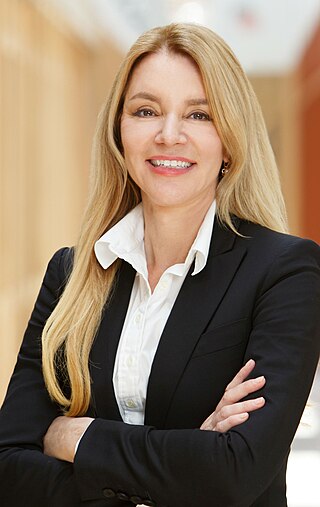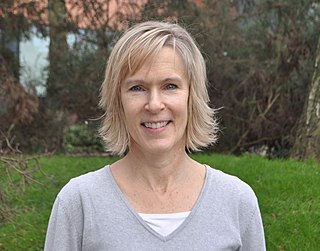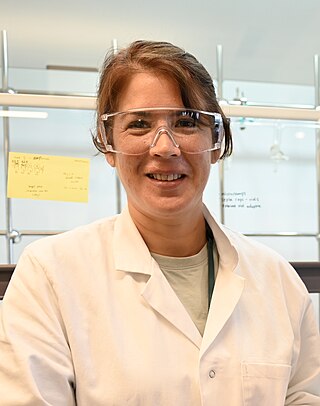Related Research Articles

Molecular engineering is an emerging field of study concerned with the design and testing of molecular properties, behavior and interactions in order to assemble better materials, systems, and processes for specific functions. This approach, in which observable properties of a macroscopic system are influenced by direct alteration of a molecular structure, falls into the broader category of “bottom-up” design.

Colloidal gold is a sol or colloidal suspension of nanoparticles of gold in a fluid, usually water. The colloid is coloured usually either wine red or blue-purple . Due to their optical, electronic, and molecular-recognition properties, gold nanoparticles are the subject of substantial research, with many potential or promised applications in a wide variety of areas, including electron microscopy, electronics, nanotechnology, materials science, and biomedicine.

Nanobiotechnology, bionanotechnology, and nanobiology are terms that refer to the intersection of nanotechnology and biology. Given that the subject is one that has only emerged very recently, bionanotechnology and nanobiotechnology serve as blanket terms for various related technologies.

Younan Xia is a Chinese-American chemist, materials scientist, and bioengineer. He is the Brock Family Chair and Georgia Research Alliance (GRA) Eminent Scholar in Nanomedicine in the Wallace H. Coulter Department of Biomedical Engineering, with joint appointments in the School of Chemistry & Biochemistry, the School of Chemical & Biomolecular Engineering, and Parker H. Petit Institute for Bioengineering & Bioscience at the Georgia Institute of Technology.
The applications of nanotechnology, commonly incorporate industrial, medicinal, and energy uses. These include more durable construction materials, therapeutic drug delivery, and higher density hydrogen fuel cells that are environmentally friendly. Being that nanoparticles and nanodevices are highly versatile through modification of their physiochemical properties, they have found uses in nanoscale electronics, cancer treatments, vaccines, hydrogen fuel cells, and nanographene batteries.

Paula Therese Hammond is an Institute Professor and the Vice Provost for Faculty at the Massachusetts Institute of Technology (MIT). She was the first woman and person of color appointed as head of the Chemical Engineering department. Her laboratory designs polymers and nanoparticles for drug delivery and energy-related applications including batteries and fuel cells.

Nicholas A. Kotov is the Irving Langmuir Distinguished Professor of Chemical Sciences and Engineering at the University of Michigan in Ann Arbor, MI, USA. Prof. Nicholas Kotov demonstrated that the ability to self-organize into complex structures is the unifying property of all inorganic nanostructures. He has developed a family of bioinspired composite materials with a wide spectrum of properties that were previously unattainable in classical materials. These composite biomimetic materials are exemplified by his nacre-like ultrastrong yet transparent composites, enamel-like, stiff yet vibration-isolating composites, and cartilage-like membranes with both high strength and ion conductance.

Eugenia Eduardovna Kumacheva is a University Professor and Distinguished Professor of Chemistry at the University of Toronto. Her research interests span across the fields of fundamental and applied polymers science, nanotechnology, microfluidics, and interface chemistry. She was awarded the L'Oréal-UNESCO Awards for Women in Science in 2008 "for the design and development of new materials with many applications including targeted drug delivery for cancer treatments and materials for high density optical data storage". In 2011, she published a book on the Microfluidic Reactors for Polymer Particles co-authored with Piotr Garstecki. She is Canadian Research Chair in Advanced Polymer Materials. She is Fellow of the Royal Society (FRS) and a Fellow of the Royal Society of Canada (FRSC).
Anna Christina Balazs is an American materials scientist and engineer. She currently is Distinguished Professor at the University of Pittsburgh and holds the John A. Swanson Chair at the Swanson School of Engineering.

Irshad Hussain is a Pakistani scientist in the field of chemistry and among the few pioneers to initiate nanomaterials research in Pakistan.
Nanoparticle drug delivery systems are engineered technologies that use nanoparticles for the targeted delivery and controlled release of therapeutic agents. The modern form of a drug delivery system should minimize side-effects and reduce both dosage and dosage frequency. Recently, nanoparticles have aroused attention due to their potential application for effective drug delivery.
Zahra Fakhraai is an Iranian-Canadian materials scientist who is a Professor of Chemistry at the University of Pennsylvania. Fakhraai does research focused on glass transition, nonlinear optics, nanoparticle plasmonics, and polymer physics. She studies the impact of nanoconfinement on the structure of materials. She was awarded the 2019 American Physical Society John H. Dillon Medal. Fakhraai was one of the researchers to start laying the ground work to better understand the optical properties of glass.

Macromolecular cages have three dimensional chambers surrounded by a molecular framework. Macromolecular cage architectures come in various sizes ranging from 1-50 nm and have varying topologies as well as functions. They can be synthesized through covalent bonding or self-assembly through non-covalent interactions. Most macromolecular cages that are formed through self-assembly are sensitive to pH, temperature, and solvent polarity.

Eva M. Harth FRSC is a German-American polymer scientist and researcher, and a fellow of both the Royal Society of Chemistry and the American Chemical Society. She is a full professor at the University of Houston and director of the Welch Center for Excellence in Polymer Chemistry.

Heather D. Maynard is the Dr Myung Ki Hong Professor in Polymer Science at the University of California, Los Angeles. She works on protein-polymer conjugates and polymeric drugs. Maynard is a Fellow of the Royal Society of Chemistry and the American Association for the Advancement of Science.
Sankaran "Thai" Thayumanavan is an Indian-American chemist, who is currently a Distinguished Professor of Chemistry at the University of Massachusetts Amherst. He is known for his work in polymer chemistry. He is a Fellow of the American Association for the Advancement of Science (AAAS).

Kristi Lynn Kiick is the Blue and Gold Distinguished Professor of Materials Science and Engineering at the University of Delaware. She studies polymers, biomaterials and hydrogels for drug delivery and regenerative medicine. She is a Fellow of the American Chemical Society, the American Institute for Medical and Biological Engineering, and of the National Academy of Inventors. She served for nearly eight years as the deputy dean of the college of engineering at the University of Delaware.
Hedi Mattoussi is a Tunisian-American materials scientist and professor at Florida State University. His research considers colloidal inorganic nanocrystals for biological imaging and sensing. He is a Fellow of the American Physical Society, American Chemical Society and Materials Research Society.

Markita del Carpio Landry is a Bolivian-American chemist who is an associate professor in the department of chemical engineering at the University of California, Berkeley. Her research considers nanomaterials for brain imaging and the development of sustainable crops. She was a recipient of the 2022 Vilcek prize for creative promise. del Carpio Landry's work has been featured on NPR, popular mechanics, the San Francisco Chronicle, and C&E News.

Christine Luscombe is a Japanese-British chemist who is a professor at the Okinawa Institute of Science and Technology. Her research investigates polymer chemistry, organic electronics, organic photovoltaics and the synthesis of novel materials for processable electronics. She serves on the editorial boards of Macromolecules, Advanced Functional Materials, the Annual Review of Materials Research and ACS Applied Materials & Interfaces.
References
- ↑ "CV" (PDF). umass.edu. Retrieved November 27, 2017.
- ↑ "Vincent Rotello". umass.edu. Retrieved November 27, 2017.
- ↑ "2010 ACS Langmuir Lecturer". Langmuir. 27 (17): 10341–10341. 2011-09-06. doi:10.1021/la202564h. ISSN 0743-7463.
- ↑ "Vincent M. Rotello" . Retrieved November 27, 2017.
- ↑ "Vincent Rotello". umass.edu. Retrieved November 27, 2017.